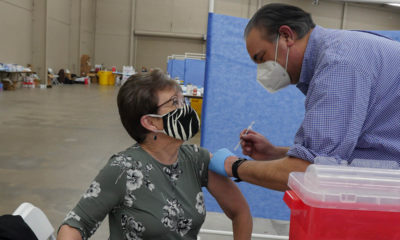Published
4 years agoon
By
AP News
DALLAS — As nurse Teri Wheat made her rounds at a Texas maternity ward, she began to realize she was having a hard time understanding the new mothers who were wearing masks due to the coronavirus pandemic.
So she got her hearing tested and now wears hearing aids.
Her hearing loss “became more noticeable the more barriers that we had to have,” said Wheat, 52, who wears a mask and a face shield at work to protect herself and others against the virus.
Hearing specialists across the U.S. say they have seen an uptick in visits from people like Wheat, who only realized how much they relied on lip reading and facial expressions when people started wearing masks that cover the nose and mouth.
“More than likely, these are people that had some kind of hearing loss prior to all this starting but they were adapting,” said Andrea Gohmert, director of the hearing clinic at the University of Texas at Dallas’ Callier Center for Communication Disorders.
Most of the time, hearing loss happens gradually and people will often wait around seven years to get their hearing tested, according to audiologists, the professionals who assess hearing.
“We would have seen these people eventually but it could have been quite a few years from now,” said Catherine Palmer, audiology director for the western Pennsylvania health care system UPMC.
Wheat, who had her hearing tested at the Callier Center in August, said that even before the pandemic, she frequently asked her kids to repeat what they said, and people pointed out how loud she listened to programs on her computer or television. But, she said, her hearing loss hadn’t been obvious to her.
Audiologists say it’s not just the lack of visual clues that’s making hearing difficult: masks and plastic barriers also reduce the sound level. And standing closer to the person you are talking to — another coping mechanism — has also been eliminated in most settings because of recommendations to socially distance during the pandemic.
Palmer, who just finished a stint as president of the American Academy of Audiology, said people with normal hearing can manage if voices are muffled a bit, but those with some hearing loss have a much harder time.
Nancy Tye-Murray, a professor at Washington University in St. Louis, said the visual is a “powerful supplement” to hearing.
“Most people with hearing loss don’t realize they rely on it so much, and even people with normal hearing rely on it, say, when you are in a noisy restaurant,” Tye-Murray said.
Palmer said adults can usually fill in the blanks and find words they aren’t hearing, but it’s exhausting.
Lorie D’Elia, an audiologist with Ohio State University’s Wexner Medical Center in Columbus, Ohio, said that once people are fitted with hearing aids they realize that “a lot of that effort of listening is taken away.”
Palmer said even people who already have hearing aids have been coming in during the pandemic to get them adjusted to manage the sound difference caused by the new barriers.
She said masks have created another problem for hearing aid wearers: They lose or damage their hearing aids when they get caught and flipped out by the ear loops.
Then there’s the dogs adopted during the pandemic chewing on or swallowing hearing aids, she said.
“Unfortunately, we’re replacing a lot of hearing aids right now as well,” Palmer said.


Tulare County Gang Member, Two Fresnans Head to Federal Prison


California Pins Vaccine Hopes on Biden Administration


Capitol Photos, Videos Lead to California Doctor’s Arrest


Vaccine Chaos: Californians Scramble for Shots Amid Mixed Messaging


AP-NORC Poll: Virus, Economy Swamp Other Priorities for US


Walters: California Still Lags Behind in Vaccinations




